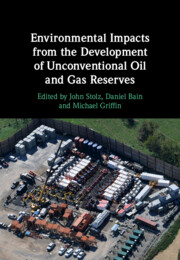Book contents
- Environmental Impacts from the Development of Unconventional Oil and Gas Reserves
- Environmental Impacts from the Development of Unconventional Oil and Gas Reserves
- Copyright page
- Contents
- Figures
- Tables
- Contributors
- Preface
- Part I Overview
- Part II Environmental Analysis
- 5 Air Quality
- 6 Methane and Climate Change
- 7 Water Usage and Management
- 8 Seismicity Induced by the Development of Unconventional Oil and Gas Resources
- 9 Naturally Occurring Radioactive Material (NORM)
- 10 Metal Isotope Signatures as Tracers for Unconventional Oil and Gas Fluids
- 11 Isotopes as Tracers of Atmospheric and Groundwater Methane Sources
- 12 The Microbiology of Shale Gas Extraction
- Part III Case Studies
- Index
- References
9 - Naturally Occurring Radioactive Material (NORM)
from Part II - Environmental Analysis
Published online by Cambridge University Press: 28 July 2022
- Environmental Impacts from the Development of Unconventional Oil and Gas Reserves
- Environmental Impacts from the Development of Unconventional Oil and Gas Reserves
- Copyright page
- Contents
- Figures
- Tables
- Contributors
- Preface
- Part I Overview
- Part II Environmental Analysis
- 5 Air Quality
- 6 Methane and Climate Change
- 7 Water Usage and Management
- 8 Seismicity Induced by the Development of Unconventional Oil and Gas Resources
- 9 Naturally Occurring Radioactive Material (NORM)
- 10 Metal Isotope Signatures as Tracers for Unconventional Oil and Gas Fluids
- 11 Isotopes as Tracers of Atmospheric and Groundwater Methane Sources
- 12 The Microbiology of Shale Gas Extraction
- Part III Case Studies
- Index
- References
Summary
The recognition of naturally occurring radioactive material (NORM) associated with oil and gas fields started nearly at the same time as the discovery of radioactivity itself. Radium in produced water is typically the source of the majority of the NORM. Four processes within oil and gas formations, solubility, alpha recoil, cation exchange, and coprecipitation lead to high radium activity in pore fluids. These processes occur regardless of the type of reservoir (conventional high permeability oil and gas reservoirs or unconventional low permeability organic-rich shale source rocks). Following well stimulation via hydraulic fracturing fluids and some solids that return to the surface contain elevated radium. The data on radium from oil and gas wells across the USA is severely lacking relative to the volumes of produced water, especially considering that large volumes are beneficially used or disposed of to surface waters. Novel treatment and accurate measurements of radium are necessary prior to beneficially reuse or dispose produced water in order to protect human and environmental health. More measurements of radium in produced water should be obtained and made publicly available.
- Type
- Chapter
- Information
- Publisher: Cambridge University PressPrint publication year: 2022



